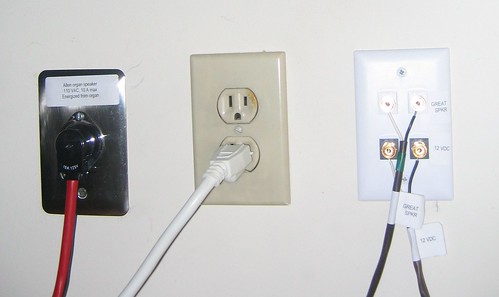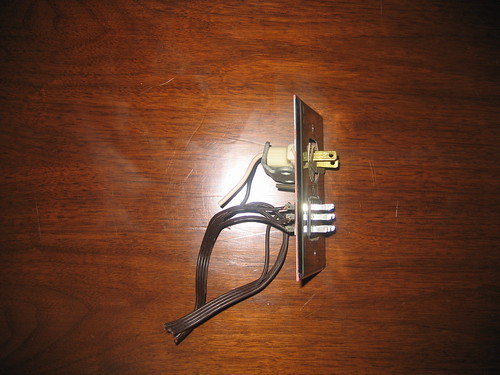Contrary to what you might think, I haven't been exactly idle on the Allen organ project. A few words on what I've been up to are probably in order.
Earlier posts in this series:
- Allen organ project - introduction
- Allen organ project - reverse engineering the card format
- Allen organ project - a software card reader
First of all, I've been busy getting the house ready to accommodate things without having a rat's nest of cables on the music room floor. This involved fishing two strands of speaker wire and a strand of Romex to each speaker. The two strands of speaker wire were for the audio and for 12VDC. The strand of Romex was for switched house current. That's what runs the motors that give the Leslie-like "gyrophonic" effects.

What's behind a speaker - Mini-Twist ML3 receptacle, an existing outlet, and a Keystone panel for audio and DC.
And behind the organ console, I fished up the other ends of all this. So behind each speaker I've got a Mini-Twist ML3 receptacle (I didn't want anyone plugging a lamp into it) and a 4-binding-post Keystone panel. Behind the organ console is a 6-binding post Keystone panel (left speaker, right speaker, and 12VDC to both), and a Mini-Twist ML2 inlet. (An inlet puts power into the wall, just as an outlet takes it out.) The arrangement that they had at the house where we got the organ was scary - the inlet was a lamp plug put on an outlet plate inside-out with some sort of putty; the low-voltage wiring was in the same box with the AC, and so on. The arrangement I have now at least isn't going to haunt my dreams.

What used to be behind the organ console - a cheap lamp plug mounted in reverse using some sort of putty, and two weird 6-pin speaker plugs, also puttied in place. How many code violations can you find in this picture?
The outlets and inlet were designed for panel mount rather than outlet box mount, so I made up nickel-plate switchplates with cutouts for them. A big "thank you" to Carl, K2YR for having the right Greenlee punch for the job!
As I did the ML2's for the various line cords, I discovered that all the AC wiring was badly deteriorated - the gutta-percha insulation unside the line cords crumbled at a touch. So I replaced all that, hacking up a hardware-store extension cord because that's a lot cheaper than the same length of 14 gauge stranded cable. I surely don't know why.
And while I was working inside the speakers, I noticed that the belts that drive the moving parts were also rotten - so I'm going to have to order a new set. OK, so I disassembled the shafts, so that I could unthread the belts to measure them. And as I was taking the brushes off the slip rings, I discovered that they were broken. Oh joy, that's a job that I'll have to get a factory service tech to do - because I can't find that part anywhere. It's a silver graphite brush, 0.125" by 0.25" by 1" with a bevel for the slip rings and a long spring. Oh well, brushes ought to be a maintenance part, so I bet the Allen tech can still get them. I hate to call a tech in for a job I can do myself, though.
So I soldered in a bypass to get power to the speakers (with quick disconnects everywhere so that I just need to yank it out to have the old arrangement back). I can live without the motion effects for a while.
I also tried replacing the burnt-out lamp in the card reader with a junk-box green LED (and current limiting resistor). Nothing doing; the thing still doesn't read cards. Next step on that device will be to replace the green LED with one of the white ones that I just got. More on that in the next post.
Pictures another time. My daughter has got my camera. [UPDATE: I got it back.]
No comments:
Post a Comment